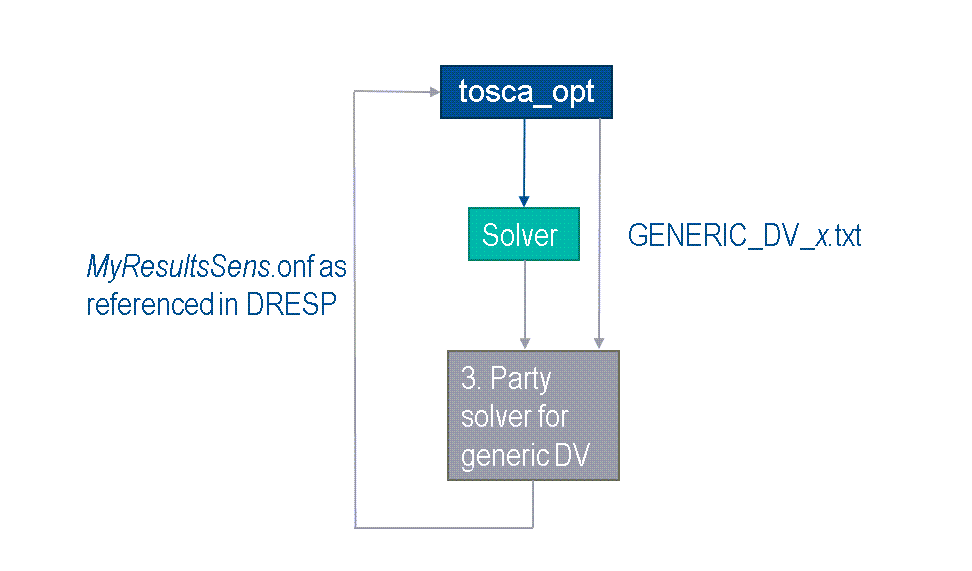About Generic Design Variables | |||||||||||
|
| ||||||||||
Introduction
Generic design variables enable Tosca to define generic optimization problems for which some design variables are not connected to nodes, elements, faces and other entities from mesh, geometry or the finite-element model. Use cases are e.g. the phase parameter β or the current in the context of an emag optimization.
All required information like design response values and sensitivity fields must come from
Tosca-external sources and must be available before tosca_opt is started.
This can be realized using a tosca_opt pre-hook.
The generic design variable values can be read from the SAVE.txt/GENERIC_DV_<iter>.txt text file
and a text-ONF file containing the design response value(s) and sensitivity information must be created by the hook.

Design Variable and Group Command
To use generic design variables, a couple of commands
are required. The design variable command, DV_GENERIC,
requires a group, which must be defined first:
GROUP_DEF ID_NAME = GROUP_FOR_GENERIC_DV TYPE = GENERIC FORMAT = LIST LIST_BEGIN 1-4 END_To create a "generic group", the TYPE of the command must be set to GENERIC. The only allowed value for FORMAT is LIST in this case, which implies that group operations are not supported. Group items for generic groups can be arbitrarily chosen and are allowed to have gaps.
The generic design variable command requires a group and allows to provide initial values with an optional ONF text file:
DV_GENERIC ID_NAME = MY_GENERIC_DV GENERIC_GROUP = GROUP_FOR_GENERIC_DV INITIAL_DV_FIELD = initial_values.onf END_The initial values are provided in text-ONF format (ONF block number 751), as a scalar field:
# Initial values for generic design variables -1 751 4 1, 0.1 2, 0.2 3, 0.3 4, 0.4 -1This initializes the generic design variables with the values 0.1 to 0.4 . It is important that the identifier in the first column match the group items defined in the
GROUP_DEF command.
DV_xxx commands are referenced in the OPTIMIZE command. OPTIMIZE can reference as usual one of DV_SHAPE, DV_BEAD, DV_TOPO, DV_SIZING. Additionally one DV_GENERIC command can be referenced.
OPTIMIZE DV = MY_SHAPE_DV DV = MY_GENERIC_DV ! ... END_
Provide Sensitivity Information
Tosca has no knowledge about the connection between a generic design variables and any entity known by Tosca. But to do optimization, derivatives with respect to the generic design variables are required and must be externally provided.
The DRESP command is required to read sensitivities with respect to the generic design variables.
DRESP
ID_NAME = MY_GENERIC_DRESP
TYPE = SENSITIVITY_GENERIC
FIELD_INPUT_FILE = MyResultsSens.onf
FIELD_INPUT_TYPE = <OBJECTIVE_ID identifier in field descriptor>
! optional, default = <ID_NAME> value
END_
FIELD_INPUT_FILE specifies the text-ONF file from which the dresp
value and sensitivity values are read. The item is optional.
If it is not specified, it evaluates to FEM_INPUT->EMAG_FILE + "_DRESP.onf"
or simply to "_DRESP.onf" if used outside an emag optimization.
The file specified in FIELD_INPUT_FILE must contain the gradient
field of the design response with respect to the generic design variables in a block
with ONF number 644. The design response value is read from ONF block with number 640.
Existing node, density and generic sensitivities are read from the ONF file if they share
the same objective_id in the descriptor.
The objective id is specified by FIELD_INPUT_TYPE.
An example is shown below:
FEM_INPUT ID_NAME = MY_FEM_INP EMAG_FILE = emag.cst END_ DRESP ID_NAME = MY_ONF_DRESP TYPE = SENSITIVITY_GENERIC ! FIELD_INPUT_FILE = emag_DRESP.onf FIELD_INPUT_TYPE = MY_ONF_ID END_
# File: emag_DRESP.onf # Dresp value -1 -2 OBJECTIVE_ID = MY_ONF_ID -2 640 1 1, -4.2 -1 # Gradient field w.r.t. nodal vector design variables -1 -2 OBJECTIVE_ID = MY_ONF_ID -2 643 2 1, -7.1e+01, 8.0, 0.0 2, 1.2e+02, -2.8e+01, 0.0 -1 # Gradient field w.r.t. generic design variables -1 -2 OBJECTIVE_ID = MY_ONF_ID -2 644 1 1, 42.0 -1
Define Upper and Lower Bounds
For generic design variables, it is important that the box constraints (absolute lower and upper bound) can be set individually for each design variable, because the different generic design variables can have very different meanings. Indeed, it is mandatory to define an upper and a lower bound for every item in the generic design variable group.
DVCON_GENERIC ID_NAME = DVCGEN_BOUNDS TYPE = BOUNDS GENERIC_GROUP = GROUP_FOR_GENERIC_DV LOWER_BOUND = 0.0 UPPER_BOUND = 1.0 GENERIC_DV_MOVE = 0.25, REL ! or ABS END_Every generic design variable might vary between 0.0 and 1.0 in this example. The
GENERIC_DV_MOVE item indicates that a design variables value
might change by 25% of the total range in one design cycle.
The move parameter can also be provided globally for all generic design variables
in a OPT_PARAM -> GENERIC_DV_MOVE command.
Output
Output for generic design variables is triggered by a USER_FILE command.
USER_FILE ID_NAME = UF_GENERIC_DV_DATA FORMAT = ASCII GENERIC_GROUP = MY_GEN_GROUP TYPE = GENERIC_DV_DATA FILE_NAME = filename.txt WRITE = EVER END_If generic design variables are used and no command with
TYPE = GENERIC_DV_DATA is present, then
it is created by Tosca and GENERIC_DV_<iter>.txt is used as file name.
Files of the form GENERIC_DV_<iter>.txt are moved into
the SAVE.txt folder.
Files generated by a GENERIC_DV_DATA user file command, but with a different file name are
not moved and can be found in the working directory.
In combination with an emag simulation, Tosca always creates files with name GENERIC_DV_<iter>.txt.
And thus this name is reserved and must not be used in own USER_FILE commands.
Limitations
- It is not supported to use solely generic design variables. Generic design variables must be combined with another type of design variables.
- Generic design variables can only be used in sensitivity based optimization setups.
- The
OPT_PARAM->DV_UPDATE_STRATEGY = MMAcannot be used together with generic design variables. - When used in combination with an emag simulation, the file name
GENERIC_DV.txtis reserved and not allowed to be used in anyUSER_FILEcommand.